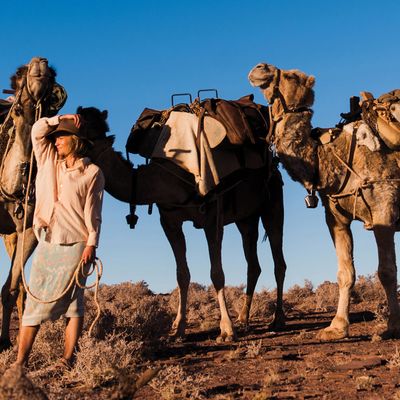
You often hear spiritually elevated people say, “It’s not the destination that matters, it’s the journey,” and that philosophy is implicit in Robyn Davidson’s celebrated 1980 memoir, Tracks, and in the meditative, powerful new film directed by John Curran. This is a work in which the very premise is repeatedly called into question: Just why does Davidson (played onscreen by Mia Wasikowska) move from the big city to trek 1,700 miles across the harsh Australian desert (from dusty Alice Springs in the Northern Territories to the Indian Ocean) with only her dog, Diggity, and four demanding camels? Among the answers: to show that she—a woman—can do it on her own. To see the country and its history—particularly its treatment of the natives—in a new light. To get away from people and the niceties of civilization—to stop having to strike poses. That makes it ironic (annoyingly so) when she has to turn for underwriting to National Geographic, which sends an American photographer, Rick Smolan (Adam Driver), to check in with her periodically and, yes, make her strike poses. In the end, the point of this ridiculous, arduous, oft-interrupted odyssey turns out to be elusive—and is all the richer for it.
Tracks takes a while to find its footing. In the early scenes, when Davidson arrives in Alice Springs and sets about learning how to handle camels, I worried that Curran’s touch would be too glancing, that his shots would be held for so little time that we wouldn’t feel the subtle rhythms—or the grinding monotony, which you need at times to feel—of life in the desert. But Curran and his cinematographer, the suitably named Mandy Walker, transfix you via other means. Distant rocks remain in tight focus yet never seem to get closer. The landscape takes on the hues of a living creature, while the living creature at the center merges with the desert, her skin a dusty brown, her bare shoulders reddened by sun and sand and hot winds. Marion Nelson’s script uses a lot of narration early on, but as Davidson moves past the tourist-overrun Ayers Rock and into Aborigine country and then hundreds of miles of dirt and sand, the verbiage runs down. Words begin to seem as precious as water.
Davidson is a prickly pear on the page: What other author in a movie-tie-in edition (with Wasikowska and Driver on the cover) would note in a postscript that the coming film “will have almost nothing to do with ‘what really happened’ ”? Oddly enough, Wasikowska looks less glamorous than photos of Davidson from the period, and she’s bracingly anti-ingratiating, one of those rare actors who can find the magic in plainness. (For a long time Julia Roberts was attached to Tracks: Can you imagine a whooping exhibitionist in the role?) Wasikowska’s Davidson winces at the arrival of Driver’s jabbering Smolan (an extreme performance, the character so immune to social cues he seems Aspergian), but softens enough to appreciate his reliability. Still, she is far easier with the bubbly Aboriginal elder “Mr. Eddie” (Roly Mintuma), who escorts her through sacred land that no woman is permitted to enter alone. And her dearest companions of all are Diggity and the camels—with their basso-profundo gurgles from a hot, sloshy underworld of phlegm and digestive juices. Curran never stops making the landscape and its inhabitants strange, so it’s a shock when Davidson arrives at her destination and we suddenly miss the world she has left. Somewhere along the way—even with moments of terror, violence, and crippling loss—the desert has become home.
The movie of Tracks has only one misstep. It ends with Smolan’s photos of the real Davidson—the ones that she has told us in print (and even, via Wasikowska, onscreen) don’t represent the truth of her experience. It’s possible that Curran means this epilogue to be ironic, but I think he’s going for the “Wow!” factor, much the way other based-on-a-true-story movies like Argo show off how faithful they’ve been. I guess it comes with the territory—Hollywood’s, not the desert’s.
*This article appears in the September 8, 2014 issue of New York Magazine.


